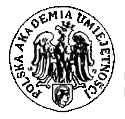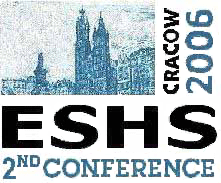Last modification: 25 September 2008
Online Book of Abstracts - A Thematic List:
SESSIONS / SYMPOSIA
Edited by Michal Kokowski
http://www.cyfronet.pl/~n1kokows/home.html
n1kokows@cyf-kr.edu.pl
Symposium R-8.
WEIGHTS AND MEASURES: THE FIRST INTEGRATION IN EUROPE?
ORGANIZER AND CHAIRMAN OF THE SYMPOSIUM:
Konstantinos NIKOLANTONAKIS (Florina, Greece)
k.nikolan@tmth.edu.gr
R-8.
First applications of the decimal metric system in Italy
Maria Teresa BORGATO (Ferrara, Italy)
bor@unife.it
The Italian republics which rose from the French revolution, together with other European governments, took part in the international Conference, held in Paris in 1798-99, on the new metric system. The foreign delegates were distinguished men of science who were involved in the works of the meeting alongside illustrious French scientists. The Italian representatives included Lorenzo Mascheroni for the Cisalpine Republic, Pietro Franchini for the Roman Republic, Ambrogio Multedo for the Ligurian Republic, Antonio Maria Vassalli-Eandi for the Piedmont government. The conference concluded with the approval of the new samples of the metre and kilogram, and it was decided to promote the new system throughout the various states.
The Cisalpine Republic, which collected into one state Lombardy, Emilia and a few provinces of the Veneto region, after careful examination of various reports, approved the division of weights, measures and money into a decimal system, and its application was made law throughout the territory of the republic. While in France the old measurements and names were abolished, in the Cisalpine Republic the former nomenclature was maintained giving new significance to favour the transformation; in particular the so-called braccio cisalpino was introduced to indicate half a metre, since it was very close to the braccio already in use in various parts of the republic, with terms used for parts of the braccio being assigned to its decimal fractions.
The process of reform came to a halt during the period of Austrian domination (August 1799 - June1800) between the first and second Cisalpine Republics, but was taken up again with the law of the 3rd February 1801: the braccio (double the Cisalpine braccio, and, therefore, equal to a metre) became the basic unit of measurement for length, its square being the unit of surface and its cube the unit of capacity.
When the Kingdom of Italy was overthrown in 1814 many Italian states went back to their old measurements and the metric system only became the national system after the Unification of Italy (law of 28th July 1861).
R-8.
The decimal metric system facing scientists and population
Suzanne DÉBARBAT (Paris, France)
Suzanne.Débarbat@obspm.fr
Simone DUMONT (Paris, France)
For a long time emperors, kings had tried to change and unify the system for weights and measures, without any success. In France, by the end of the 17th century, several proposals appeared, but they were unsuccessful; the same occurred by mid-eighteen century. Following the changes brought by the 1789 Revolution, a new system was created, despite the opinion of Lalande, not favourable while Borda was. New measurements of a meridian arc were made and a final decision taken in 1799. Despite the interest showed by the scientists and, among them astronomers, despite actions of "savants" such as Laplace, the population was against, as usual in France when something has to modify the habitudes. Forty years later an hard decision was taken, in 1837, to apply on 1840 January 1. A French song, most probably issued at that time, demonstrates how the changes were seen by the population.
R-8.
Gauß, Meyerstein and Hanoverian precision weights and measures
Klaus HENTSCHEL (Berne, Switzerland)
Khentsc@aol.com
The practice of precision weighing as perfected by Carl Friedrich Gauß (1777-1855) and his instrument maker Moritz Meyerstein (1808-82) is portrayed by Klaus Hentschel on the basis of unpublished sources in the archive of Göttingen University and elsewhere.
In August 1836, a new law on weights and measures was issued at St. James's palace in London, soon followed by further instructions for the Hanoverian territory. The interior ministry, the Königlich-Großbritannisch-Hannoversches Ministerium des Innern, decreed that Gauß, already well-known for his meticulous geodetic measurements and other services to the British sovereign, develop new precision weights and measures. Among these were length and volume measures conformed to the new legal prescriptions from London. Gauß met this challenge in precision measurement in close collaboration with the university mechanic and machine inspector Meyerstein. After many trials and tribulations, they finally produced two copies of the new Hanoverian normal pound with an error margin of less than one thousandth gram, i.e., with a relative accuracy of roughly 2 × 10-6. The many small innovations introduced by Meyerstein and Gauß in precision balance design and in the weighing procedures in order to reach this incredible precision will also be described in detail. For further information on Meyerstein, the reader is referred to Klaus Hentschel: Gaussens unsichtbare Hand. Göttingen 2005 (= Abhandlungen der Göttinger Akademie der Wissenschaften, math.phys. KJlasse, Vol. No. 53) and to the url: http://www.cx.unibe.ch/~khentsch/meyerst.html
R-8.
Weights and measures of the Spanish military engineers until the metrical unification
Juan NAVARRO LOIDI (Rentería, Basque Country, Spain)
jnavarrolo@euskalnet.net
Pilar MERINO SAENZ (Rentería, Basque Country, Spain)
The Spanish army took part in many of the wars that have endured Europe during the last centuries. The Spanish military engineers had to be conscious of the great variety of units of measurement that were used in the diverse countries. On the other hand, there was not properly a Spanish school of fortification. The Spaniards followed successively the doctrines on fortification proposed by Italian, Dutch and French engineers. For all this in the treatises on fortification published in Spanish before the nineteenth century a worry by the existence of many different systems of measurements in Europe is observed.
Several Spanish military men collaborated in the first efforts for creating a natural universal and rational system of unities of measurements done by French scientists. But, when the Crown ordered in 1801 the generalization of the units of the former kingdom of Castile to all its possessions, the instruction was quite well accepted by the army. The war against Napoleon did not help the acceptance of the Metric Decimal System.
During the implantation of the Metric Decimal System in Spain, which began in 1848 and ended in 1880, the military men accepted well the new units, but they did not occupy a leading position in this introduction, as it did in many other political questions during that century.
In this communication this process is studied, seeing the commentaries that are done in the Spanish treatises of fortification during these centuries on the existence of many different systems of measurements. Also there are presented the units that were used in these books, observing the successive opinions that existed in the Spanish army up to the full implantation of the Metric Decimal System.
R-8.
Weights and measures: the Greek efforts to integrate the metric system
Konstantinos NIKOLANTONAKIS (Florina, Greece)
k.nikolan@tmth.edu.gr
Even if the metric system did not become initially acceptable with enthusiasm, its adoption from other nations began to increase regularly after its obligatory use in France in 1840. To the dues 1860 became obvious the need for more precise and of course determined units, because of the requirements created by the new scientific discoveries. This became possible with the Meter Convention in 1875, an international agreement in which participated 17 countries, while up to 1900 35 nations have accepted officially the metric system. This convention has determined with precision the units and the mechanisms for the constitution and adoption of further determinations in the metric system. In the countries of Europe the complete establishment of the Metric system took place through different conditions and in different periods.
Our presentation will focus on the situation in Greece and will examine the evolution from the ancient Greek weights and measures to the final and total acceptance of the metric system in 1959. We will examine the use of other metric systems during the Antiquity, the Roman, Byzantine and Ottoman period and we will focus on the political decisions and laws from 1836, via 1920 to 1959. We will study the Royal Decree No 56 of 1836 On Weights and Measures which reflects the existence of an agricultural society, the Law 2526 of 1920 On Weights and Measures which reflects the industrial and scientific evolution in the context of the Greek society and the Legislative Decree 3957 of 1959 On the Introduction in Greece of the International Metric System which shows the total acceptance of the Metric System.
R-8.
Success and constraints in the adoption of the metric system in Portugal
Fátima PAIXAO (Castelo Branco, Portugal)
fatimapaixao@ese.ipcb.pt
Fátima Regina JORGE (Castelo Branco, Portugal)
frjorge@ese.ipcb.pt
During several centuries, the successive Portuguese reforms of weight and measures failed their intents, contributing even, in some occasions, to the damage of the situation. However, the country was in the first line when the adoption of the French metric system, probably by the impulse of Lisbon earthquake devastation in 1755, where the official standards were, supposedly, destroyed or lost.
At the same time the full adoption of the metric system was not free from problems and difficulties due to the particular history of the country.
Three years after the establishment of the new metric system in 1799, Portugal imported from France prototypes of the adopted units. In 1812 a Real Commission was created for the Examination of Administrative Registers and the Development of Agriculture and, in 1814, it proposed the adoption of the new French metric system. This seems a spectacular acceptance of the new ideas. However the country has been invaded and largely aggressed by the French army between 1807 and 1811, and the Commission, conscious of the popular repugnance to everything with French connotation, defended in its Report the non use of the French names for the new units to be adopted. The old names persisted practically until nowadays, maybe due to the reluctance concerning the new designations or to a country socially centred in a poor, closed agricultural system.
By the end of 1852 a real law in decree imposes the full adoption of the French metre as the base of the legal system of weights and measures in the continent and oversees islands as well as the whole nomenclature of the decimal metric system to designate the several units, multiples and submultiples. The same decree in law establishes ten years to the complete adherence to the new system. In 1875, Portugal integrated the first contingent, participating in Paris in the Conference of the Metre and signing the formal approval of the Metre Convention.
In our opinion, Portugal rapid approval of the metric system in the first convention gets a better understanding in the light of two relevant historical episodes: Lisbon earthquake and the French invasions. We will develop our argumentation and report some curious aspects contributing to the history of the adoption of the Metric system in Europe.
R-8.
In search of common standards - the 1650 computer
of Casimir Simienowicz for
Weight Conversions
Romualdas SVIEDRYS (Brooklyn, N.Y.,USA)
rsviedrys@hotmail.com
Long before the development of the metric system during the French Revolution, there were developments that were anticipating various types of numerate integrations within Europe. Several such trends are worth exploring because they were attempts at resolving the chaotic situation when proliferation of standards was imposing constraints on commerce, industry and scientific communications.
The first ones to experience the urgent need for integration and some sort of common standards were the merchants. There were many publications listing the weight, volume and other measures used in European cities. Many such booklets were published in Amsterdam, as by 1600 the Dutch were clearly in the lead in European trade. Another equally urgent need was felt among artillerist, one of whose proposed solutions we shall examine here in greater detail.
Casimir Simienowicz published in 1650 his book, The Great Art of Artillery. It was published in Amsterdam in Latin but was translated into the main European languages (French 1651, German 1676, English 1729). In its opening section, Simienowicz reviewed the chaotic situation of cannon calibers and different weight standards all over Europe and introduced a simple paper computer to convert quickly a given weight from any of the 228 cities into another city's equivalent weight through a conversion to a common standard that he arbitrarily picked.
R-8.
The Netherlands and the International Bureau of Weights and Measures
Frans van LUNTEREN (Amsterdam-Utrecht, The Netherlands)
f.h.vanlunteren@phys.uu.nl
Both in the 1790's and the 1870's Paris hosted international meetings concerned with the standardization of weights and measures. In both cases Dutch representatives played a prominent role in the negotiations. But there is a striking contrast in the political maneuvers of the Dutch state following each of these conferences. Whereas in the 1810s the Netherlands had been one of the few European states to adopt the new metric system, in 1875 the Dutch were exceptional in their refusal to sign the Metric Convention and in their consequent withdrawal from the Comité International des Poids et Mesures, which was to supervise the activities of the future Bureau International des Poids et Mesures. In both cases these political decisions were predominantly based on the advice of the Dutch scientists who had represented the state at the international conferences.
In the latter case we are dealing with Johannes Bosscha, professor of physics at the Delft Polytechnic. In Dutch scientific circles Bosscha's opposition to the establishment of the Bureau and his negative advice to the government had been highly controversial. It is perhaps telling that immediately after Bosscha's decease in 1911 the Dutch Academy advised the government to join the CIPM. Pieter Zeeman's entry into the CIPM in 1929 finally ended the Dutch isolation.
In this talk I will discuss Bosscha's steps and motives as well as the resulting disputes in the Academy with the reputed physiologist Franciscus Donders. At the bottom of this controversy were different loyalties as well as different perceptions of the proper role and nature of scientific institutions.
R-8.
Money: from virtual reality to the real thing - Emerging national currencies and the transformation of traditional peasant economy in Northwest Germany
Karl-Heinz ZIESSOW (Cloppenburg, Germany)
ziessow@ballodora.de
The paper explores effects and reactions stimulated by the standardization process during the creation of a national currency in Germany from 1830 to 1871 with regard to their historical background in the structures and mentalities of rural societies. The thesis is, that procedures of market nationalization didn't mean to replace a predominantly barter economy, determined by traditionally social relationships, but to transform a highly complex rural system of weights, measures and monetary systems.
Except for a few extremely impoverished regions, peasant literacy had spread continuously in Northwest Germany since the early 17th century. Using literacy as a means of sustainable government, modern territorial monarchies based their fiscal power on a network of corresponding (clerical) parish and (civil) county administrations, thus combining bureaucratic standardization and moral obligation.
The effect of this political communalism on rural societies has been vigorously studied during the last decades: With growing territorial administration the proper weight of bureaucracy created its counterpart in formalized farmstead budgeting. Peasant account books show an abundant variety of examples for these everyday economic procedures. Probate inventories present additional evidence for the amount of credit contracts and the degree of informal finance in early modern rural societies.
In the age of the Napoleon wars this political economy rapidly perished and restauration never successfully tried to reestablish this part of the ancien régime. The gradual replacement of a wide range of accepted currencies - including the Netherland "Gulden" - in every Northwest German territory after 1815 was then immediately perceived as a withdrawal of valuable coins. For the time being, the virtual Gold standard remained in effect, before the effects and benefits of unification could - more or less retrospectively - be applied.




